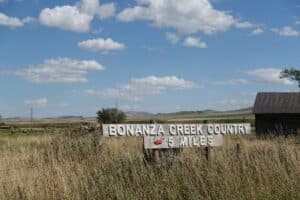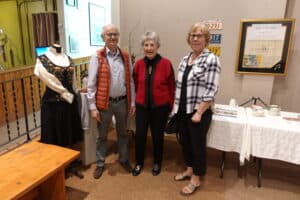
In July 2025 it will be 200 years since the first organized group of Norwegian immigrants left the city of Stavanger, Norway. Cleng Peerson was their pathfinder in western New York in 1825, and in Fox River, Illinois, in 1833. His last 15 years in Texas have been a mystery. Most Norwegian immigrants settled in the Mid-West. Why did he choose to live in Texas?
A 200 years’ celebration – to be continued!
With good reason Peerson got the nickname: Father of Norwegian Emigration. Planning to commemorate the occasion in 2025 is now under way by official Norway, and by the Norwegian American Historical Association (NAHA) in the Midwest.
This website, clengpeerson.no, is on its own journey to document and spread this part of the large and ongoing migration story. We are independent in relation to all officially organized planning of the 200-year anniversary in Norway and to that of NAHA at St. Olaf College. We will co-operate actively whenever that might be of interest to the official organizations in both countries.
In March 2024 the book by Gunnar Nerheim, Norsemen Deep in the Heart of Texas. Norwegian Immigrants 1845-1900, will be published by Texas A&M University Press.
The forgotten West
From now on and the next two years we will publish research-based articles with academic references within the scope of these internet pages. We will concentrate on Norwegians in Texas, Montana, Alberta, and Saskatchewan. There are two reasons for that: Gunnar Nerheim has done historical research on Norwegians in these places for more than 15 years. Also, his research and our many conversations with Norwegian descendants in USA and Canada has shown that there is a tendency to forget the Norwegian immigrants in these states and Provinces. The internet pages will try to focus some of the limelight on them.
Feedback from our readers

Every week we analyze our statistics; how many visitors are there at our site, where do they come from, and what are the pages that most people spend time on? We also get direct feeedback from our readers. There are many readers from countries we never expected would be interested in a research-based internet page about migration which began in Norway.
We expected that most of our readers would be Norwegians. That is not the case any more – Norwegians are the second largest group, after Americans, and Canadians will soon be number two. United Kingdom and EU countries are also active, and countries on the Asian continent and in Africa. Evidently, most readers do not speak Norwegian. From June 2023 we have decided that all articles will be written in English. This decision has already created an increase in the number of readers, especially in the US and Canada, and in the number of people who contact us. Hopefully, readers are competent in using translation software. Letters to us can likewise be written in English, Scandinavian, German, French and Spanish.
How did this journey begin?
Gunnar Nerheim began his research on “Norwegians in the last best west” back in 2006, as a coincidence or a side story to the work he was doing then. He visited Calgary for the second time in connection with his work on the history of Norwegian oil, to compare the oil city Stavanger with Houston and Calgary. He spent days in the archive of the Glenbow Museum, and still has boxes full of copies from Calgary in his office.
During a weekend in fall 2006 he drove north to visit the Leduc Museum. On the way he stayed over in Wetaskiwin, where he visited the Reynolds Museum. As a former CEO of the Norwegian Museum of Science and Technology in Oslo he found the Reynolds Museum absolutely splendid. On the same day he drove east to Camrose, and on the way he saw the sign Sulitjelma Road. Wow! there must be Norwegian immigrants living in this area, he thought, since they had named a road in Alberta with a Norwegian name!
Norwegians in Canada?
It became the starting point for doing research on Norwegian immigrants on the Canadian prairies.
Since that time, he has written a couple of hundred pages about Norwegians in Canada, which never have been published. Most of the research and writing was done in between his duties as vice dean of research at the Faculty of Humanities at the University of Stavanger. On a visit in March 2012 to Bosque Museum in Clifton, Bosque County, Texas, he discovered a lot of new material on Cleng Peerson and the Norwegians in Texas. This became the main project until 2020.
…. in Montana, Alberta and Saskatchewan
In October 2014 Gunnar visited Montana for the first time in his life. He needed to visit the Montana Historical Society in Helena, and the Special Collections at Montana State University in Bozeman. Since 2014 he has been back to do research with Inger Kari – in 2016 and 2018. In 2018 he no longer sifted and copied interesting archives, but scanned them, with Gunnar picking out the documents and Inger Kari scanning them. We did twice as much and more than one person would be able to.
In September 2023 we met enthusiastic sons, daughters and grandchildren of Norwegian immigrants in Montana, Alberta and Saskatchewan, during thirty days on the road. It was an inspiring journey, a road-trip of high caliber — all thanks to the enthusiastic and knowledgeable people we met at each and every location. Because of that, you will find that we have made several changes.
www.clengpeerson.no They came to build
You opened your homes to us, museums and archives, and churches. We visited old townsites which had once been thriving, we walked the graveyards and looked at familiar names: we can find them in our own Norwegian neighborhood, as well.
We spent time with the living and vibrant communities of descendants from all over Norway – and Sweden, and Finland and Denmark, and Germany, and Ireland, and Scotland, and Hungary. It was all about migration, and of what they did when they came.

It struck us one day, discussing what we had experienced: They all came in order to achieve something. They raised crops, buildings, barns, built railroads, churches, schools. They took part in local groups and organizations, they served as sheriffs, commissioners and even senators and Congress members.
After our trip and our talks with you, we created a whole new logo for our website: www.clengpeerson.no They came to build.
Thank you, all of you!
clengpeerson.no – our take on migration
Migration is often described as a journey where a few, the unique individuals, stand out and act as leaders. We also highlight some of them in the pages. But more than often we lift out from the throng the ordinary people who through their endeavors with family and friends and acquaintances built a new life for themselves and each other.
Gunnar has written about his research ethos in the foreword to Norsemen Deep in the Heart of Texas. He looks at the individuals in their groups and in their larger context, and how they, wherever they came, contributed to their new chosen habitats. The research and meeting all of you has made Gunnar’s focus even more important to us: this is a GROUP story. It was -“back then” – always about people who lived IN their society, looked for opportunities and tried their best in their circumstances.
Not one of them could have made it alone. Norwegian customs and Christmas cookies are still symbolic carriers of Norwegianness, for many of us. Whatever Norwegianness still may be, you all showed us you choose to be people and descendants of people who wanted to build, take responsibility, bringing to the new home what was valuable to keep, and leaving behind that which was not.